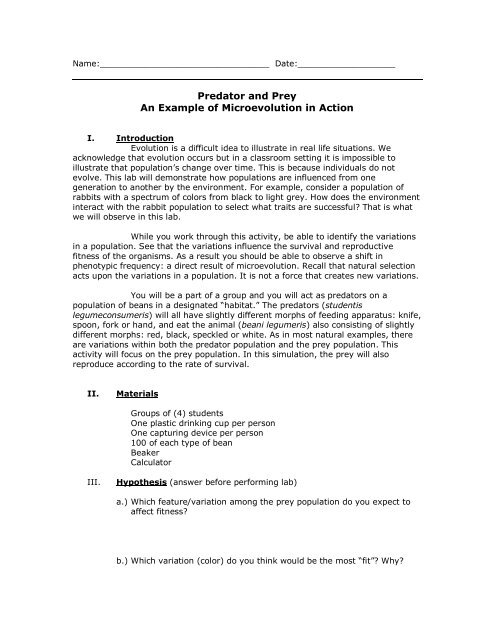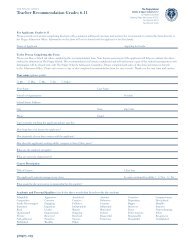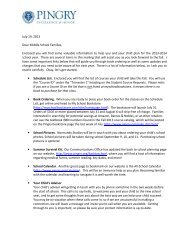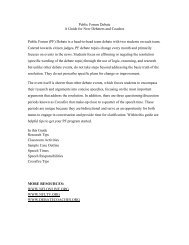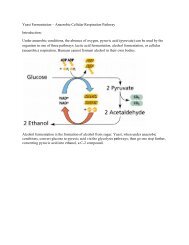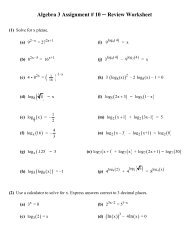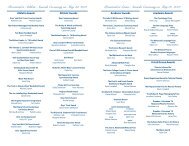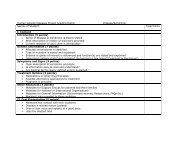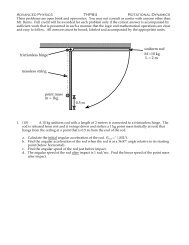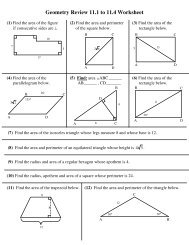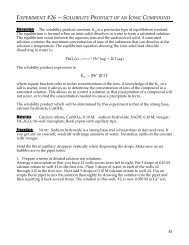Predator and Prey An Example of Microevolution in Action
Predator and Prey An Example of Microevolution in Action
Predator and Prey An Example of Microevolution in Action
Create successful ePaper yourself
Turn your PDF publications into a flip-book with our unique Google optimized e-Paper software.
Name:_________________________________ Date:___________________<br />
<strong>Predator</strong> <strong>and</strong> <strong>Prey</strong><br />
<strong>An</strong> <strong>Example</strong> <strong>of</strong> <strong>Microevolution</strong> <strong>in</strong> <strong>Action</strong><br />
I. Introduction<br />
Evolution is a difficult idea to illustrate <strong>in</strong> real life situations. We<br />
acknowledge that evolution occurs but <strong>in</strong> a classroom sett<strong>in</strong>g it is impossible to<br />
illustrate that population’s change over time. This is because <strong>in</strong>dividuals do not<br />
evolve. This lab will demonstrate how populations are <strong>in</strong>fluenced from one<br />
generation to another by the environment. For example, consider a population <strong>of</strong><br />
rabbits with a spectrum <strong>of</strong> colors from black to light grey. How does the environment<br />
<strong>in</strong>teract with the rabbit population to select what traits are successful? That is what<br />
we will observe <strong>in</strong> this lab.<br />
While you work through this activity, be able to identify the variations<br />
<strong>in</strong> a population. See that the variations <strong>in</strong>fluence the survival <strong>and</strong> reproductive<br />
fitness <strong>of</strong> the organisms. As a result you should be able to observe a shift <strong>in</strong><br />
phenotypic frequency: a direct result <strong>of</strong> microevolution. Recall that natural selection<br />
acts upon the variations <strong>in</strong> a population. It is not a force that creates new variations.<br />
You will be a part <strong>of</strong> a group <strong>and</strong> you will act as predators on a<br />
population <strong>of</strong> beans <strong>in</strong> a designated “habitat.” The predators (studentis<br />
legumeconsumeris) will all have slightly different morphs <strong>of</strong> feed<strong>in</strong>g apparatus: knife,<br />
spoon, fork or h<strong>and</strong>, <strong>and</strong> eat the animal (beani legumeris) also consist<strong>in</strong>g <strong>of</strong> slightly<br />
different morphs: red, black, speckled or white. As <strong>in</strong> most natural examples, there<br />
are variations with<strong>in</strong> both the predator population <strong>and</strong> the prey population. This<br />
activity will focus on the prey population. In this simulation, the prey will also<br />
reproduce accord<strong>in</strong>g to the rate <strong>of</strong> survival.<br />
II.<br />
Materials<br />
Groups <strong>of</strong> (4) students<br />
One plastic dr<strong>in</strong>k<strong>in</strong>g cup per person<br />
One captur<strong>in</strong>g device per person<br />
100 <strong>of</strong> each type <strong>of</strong> bean<br />
Beaker<br />
Calculator<br />
III.<br />
Hypothesis (answer before perform<strong>in</strong>g lab)<br />
a.) Which feature/variation among the prey population do you expect to<br />
affect fitness?<br />
b.) Which variation (color) do you th<strong>in</strong>k would be the most “fit”? Why?
IV.<br />
Procedure<br />
1. Count out 100 beans <strong>of</strong> each type <strong>and</strong> place <strong>in</strong> your group’s<br />
beaker. The beans are now bugs. You will spread these over<br />
the habitat area outside.<br />
2. We will all go outside together.<br />
3. Use the str<strong>in</strong>g to designate boundaries for your habitat.<br />
4. St<strong>and</strong> around the habitat <strong>and</strong> prepare to forage for food. Turn<br />
your backs to the habitat until you are told to start.<br />
5. At my count, you will be given 1 m<strong>in</strong>ute to forage for food.<br />
Catch as many bugs as you can. Color does not affect the<br />
nutritive value. Catch as many bugs as you can <strong>and</strong> put them<br />
<strong>in</strong> your cup.<br />
a. You must ONLY use your particular captur<strong>in</strong>g device.<br />
You may not scoop with the cup.<br />
6. When I say “stop” <strong>and</strong> you have a bug <strong>in</strong> your captur<strong>in</strong>g<br />
device but not <strong>in</strong> the cup, you must release the bug back <strong>in</strong>to<br />
the habitat.<br />
7. Each predator determ<strong>in</strong>es the number <strong>of</strong> prey captured.<br />
a. i.e. 21 speckled, 5 black, 13 red, etc.<br />
b. Enter the data <strong>in</strong>to your chart. Record the number <strong>of</strong><br />
each bug captured by the rest <strong>of</strong> your group.<br />
c. Calculate the number <strong>of</strong> each bug rema<strong>in</strong><strong>in</strong>g <strong>in</strong> the<br />
population (100 – total <strong>of</strong> each type caught) for round 1.<br />
8. Before the next round, the rema<strong>in</strong><strong>in</strong>g bugs will be allowed to<br />
reproduce. Count out one bean <strong>of</strong> the appropriate color for<br />
each bean rema<strong>in</strong><strong>in</strong>g <strong>in</strong> the habitat. If 65 beans were<br />
captured, that means 35 rema<strong>in</strong> <strong>in</strong> the habitat. So count out<br />
35 beans <strong>and</strong> put them <strong>in</strong> the beaker to represent the<br />
<strong>of</strong>fspr<strong>in</strong>g. Repeat for all the colors <strong>and</strong> mix them <strong>in</strong>to your<br />
group’s beaker. (You should be doubl<strong>in</strong>g the surviv<strong>in</strong>g<br />
population by do<strong>in</strong>g this.)<br />
9. We will try to complete 5 rounds. Work quickly.
V. Results/<strong>An</strong>alysis<br />
1. Complete calculations for all generations.<br />
2. Create an Excel table <strong>and</strong> graph to represent which predator<br />
was the most successful us<strong>in</strong>g % <strong>of</strong> prey captured.<br />
3. Create an Excel graph which shows the number <strong>of</strong> bugs<br />
surviv<strong>in</strong>g versus the generations.<br />
4. Remember to <strong>in</strong>clude a key <strong>in</strong> your graph. There should be a<br />
title <strong>and</strong> labels for each coord<strong>in</strong>ate along with appropriate<br />
units.<br />
5. Turn <strong>in</strong> the follow<strong>in</strong>g: (Due May 23, 2008)<br />
a. A lab report <strong>in</strong>clud<strong>in</strong>g an <strong>in</strong>troduction, materials list,<br />
procedure, data table from packet, excel table <strong>and</strong><br />
graph <strong>and</strong> the answers to the discussion questions.<br />
b. You may submit as many drafts <strong>of</strong> your lab report as<br />
you’d like up to the due date.<br />
VI.<br />
Discussion Questions<br />
1. Describe <strong>in</strong> a paragraph or two what happened <strong>in</strong> this<br />
predator/prey simulation. Include <strong>in</strong> your description the<br />
follow<strong>in</strong>g: environment, variation, survival, reproduction, <strong>and</strong><br />
fitness.<br />
2. Which variation <strong>in</strong> the populations <strong>of</strong> bugs had the greatest<br />
survival rate? Why?<br />
3. Do you th<strong>in</strong>k your results would have been different if we did<br />
this activity a few months ago <strong>in</strong> a “habitat” <strong>of</strong> snow? Why?<br />
4. Do you agree or disagree with this statement? Why? Expla<strong>in</strong>.<br />
“A particular adaptation that <strong>in</strong>creases fitness <strong>in</strong> one<br />
environment may not necessarily do the same <strong>in</strong> other<br />
environments.”
Population<br />
Initial<br />
Population<br />
(1)<br />
Generation 2<br />
Generation 3<br />
Generation 4<br />
Generation 5<br />
White Black Red Speckled Total<br />
Initial Population 100 100 100 100 400<br />
Number captured by you<br />
Number captured by others<br />
<strong>in</strong> your group<br />
Total captured by your group<br />
Number rema<strong>in</strong><strong>in</strong>g after<br />
round 1<br />
Percent <strong>of</strong> total<br />
population (%)<br />
Number captured by you<br />
Number captured by others<br />
<strong>in</strong> your group<br />
Total captured by your group<br />
Number rema<strong>in</strong><strong>in</strong>g after<br />
round 1<br />
Percent <strong>of</strong> total<br />
population (%)<br />
Number captured by you<br />
Number captured by others<br />
<strong>in</strong> your group<br />
Total captured by your group<br />
Number rema<strong>in</strong><strong>in</strong>g after<br />
round 1<br />
Percent <strong>of</strong> total<br />
population (%)<br />
Number captured by you<br />
Number captured by others<br />
<strong>in</strong> your group<br />
Total captured by your group<br />
Number rema<strong>in</strong><strong>in</strong>g after<br />
round 1<br />
Percent <strong>of</strong> total<br />
population (%)<br />
Number captured by you<br />
Number captured by others<br />
<strong>in</strong> your group<br />
Total captured by your group<br />
Number rema<strong>in</strong><strong>in</strong>g after<br />
round 1<br />
Percent <strong>of</strong> total<br />
population (%)


